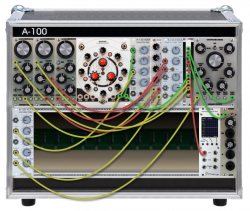 ModularGrid – a site that lets you design modular synthesizers, based on existing modular modules – has introduced a new feature.
ModularGrid – a site that lets you design modular synthesizers, based on existing modular modules – has introduced a new feature.
TrueGrid is a web-based modular synthesizer which lets you create, listen and share modular synth patches. You can create your own patches by dragging cables from module outputs (green) to module inputs (blue) sockets.
See the ModularGrid site to try it out.

You might want to mention that it only works for Google Chrome, and the fact that a lot of peep’s don’t like Google anything.
Oh, people disliking Google is as relevant as people disliking Apple for this article so cut the crap next time please.
Seems relevant enough to me. You may have missed the point.
“Note: This web-based modular synth emulation only works on Google Chrome.”
Your comparison to that being like Apple bashing is way off base. Every article about apps will specify if it is on iOS, or Android, or Mac OS, or Windows. It’s just asking for system requirements (essentially). Bjorn is just saying WHY this information is relevant to him. I’m not about to install Google Chrome just to play with this synth.
Alternatively you could use the open source Chromium which is like Chrome but without all the Google stuff.
Completely understand your criticism, but I have to start at one point.
I like to support as many platforms as possible but to be realistic: TrueGrids technology is founded on a W3C standard which is still in “draft” status.
A bug in the current Safari version prevents it to make use of the modulation bus feature.
I am confident that the next Safari version will fix this very soon.
Firefox may follow after that. IE … I don’t count on that one…
You will download Google Chrome right now if you like modular synthesis… simple as that.
I like modular synthesis – I didn’t download it.
I’ll maybe give it a go if/when it’s compatible with my browser – but unless it turns out to be earth shatteringly good, I’ll stick to the hardware and VSTs that do the same thing in a more useful format.
LOL! It really wasn’t very good at all. I was wrong… however if they are able to get this thing up to snuff, I won’t see how having to download Chrome to run it will get in the way at all. If they let you choose the amount of modules and offer a good selection of modules with all of their inputs it could possibly be the first Java app to replace any synth VST!… probably just a dream though
One might also mention that a 3-oscil 1 filter patch uses around 140 MB memory and sucks 25-30% of a rather nifty CPU.
Not to say your points about compatibility and performance aren’t valid (in the end, those are 2 hugely important factors…most important in fact), but I think it would be wise to step back and consider that these browser-based sound tools are still in a proof-of-concept phase. I’ve never found one that worked particularly well or sounded anything close to a desktop equivalent. But the idea is exciting enough to merit some appreciation and support. Many people are overwhelmed by modular synthesis, scared to try it out, or it’s too expensive to piece together a decent rack.
Some day there will be a strikingly delicious browser-based DAW, complete with its own set of virtual instruments. I only hope that the modular community is willing to accept and embrace these soft-emu’s, as the low-no price point is capable of drawing all the timid, overwhelmed masses out of their ignorance (not an insult) and let them grow comfortable with literal patching.
The strongest appeal of a modular synthesizer for many people is not the sound, it’s the tactile interface.
Now matter how good your VST or a future Web DAW will sound, it will be no replacement for that reason.
With that opinion I still worked on TrueGrid to give people, like Uglykidmoe pointed out, the opportunity to experiment and get an understanding how basic modular blocks work. And how less you need to turn a saw wave into an utterly mess.
The most exciting possibilities of web based instruments in the future will be the connection of users, that will be the point when things start to get interesting. TrueGrid indicates this with the possibility to listen to sounds of other people. A little clumsy but still: you have to start at one point.
Knut Schade – points well taken. I’m happy to see this thing, and frankly, I think it works pretty damn well.
I enjoy going through and seeing what racks and patches people can dream up. Very interesting and as you said, opens up modular to a whole new world of collaboration.
http://www.youtube.com/watch?v=-kl4hJ4j48s